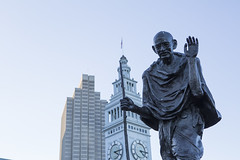![]()
![]()
![]()
Use LEFT and RIGHT arrow keys to navigate between flashcards;
Use UP and DOWN arrow keys to flip the card;
H to show hint;
A reads text to speech;
28 Cards in this Set
- Front
- Back
|
1)India in the 18th Century and on •Indiawas not yet a superpower when it was under the British colonization. TheBritish were there since the early ___ ________ but India was in effect colonized by ____-____ _________ with intense exploitation of its resources and people. |
18th Century mid-19th Century |
|
|
•Indian nationalism started to emerge and there were repeated movements for independence – finally the _____-________ one occurred under the leadership of _________ ________ and India became in independent in _______ with the separation of independent Pakistan. |

non-violent Mahatma Ghandi 1947 Pakistan. |
|
|
2)Key spiritual figures in Hinduism •Thosefigures appeared not just in India but also had their place in the__________ arena |
international •They were influential in their tolerance for the other, were willing to converse with other figures from other world religions |
|
|
2) Key spiritual figures in Hinduism •In late 19th Century there was in the West, the city of Boston, 1893, for the first time the ______ _________ _____ __________ – and their scholars for dialogue and sharing spiritual insights |

Boston, 1893 WorldParliament of Religions |
|
|
3) SwamiVivekananda •Greatinfluence in the _____ between ________ and ____ ______ |
West London and New York |
|
|
3) Swami Vivekananda •Authorof : |

Karma-Yoga Raja-Yoga Bkhati Yoga |
|
|
3) Swami Vivekananda •His close friend and a convert to Hinduism,______ ________tried much to bring deeper understanding to the ______ about Hinduism |
Sister Nivedita West |
|
|
3) Swami Vivekananda •Vivekananda was not after gaining _______ but rather how deeper understanding and respect of all ________ will make Christians better Christians, Muslims better Muslims, Jews better Jews, Hindus better Hindus and so on. |
converts religions |
|
|
3) Swami Vivekananda •Thepre-supposition of Vivekananda that all religions are _____ |
true
|
|
|
3) Swami Vivekananda •His disciple Sr Nivedita was of ________-_______origin, and was a: |

Scots-Irish social worker, author and a teacher |
|
|
3) Swami Vivekananda ______ ________travelled to _______ after she met with Vivekananda in ________ |

Sister Nivedita Calcutta London |
|
|
3) Swami Vivekananda •Nivedita means “________ ____ _________” and her Vivekananda coached her into ________ |

dedicated to God celibacy |
|
|
3) Swami Vivekananda Sister Nivedita opened ________ in Calcutta for ______ _______ and dedicated her life in the serviceof the ______ |

school young girls poor |
|
|
3) Swami Vivekananda Sister Nivedita gave her life for India and died when and where? |

in Darjeling in 1911 |
|
|
3) Swami Vivekananda •Sister Nivedita grew up in the __________ faith but ____________ religious life did not appease her much |
Christian regulated |
|
|
3) Swami Vivekananda ________ __________ subsequently studied other religions and upon meeting with Vivekananda he answered all her questions and dispelled all her doubts. She became his ___________ shortly after |
Sister Nivedita disciple |
|
|
3) Swami Vivekananda Sister Nivedita also got interested in ____________ |
Buddhism
|
|
|
3) Swami Vivekananda •Vivekanandaencouraged Sister Nivedita to go to India and serve the ________ ________ there who were indismal situation with respect to _________ _________ |
Indian women personal rights |
|
|
3) Swami Viveka Sister Nivedita opened ________ for ________ to overcome women’s sorry state in India at the time |
schools girls |
|
|
3) Swami Vivekananda •Vivekananda considered Sister Nivedita a gift from ________ to India despite the ________ __________ |
England British colonization |
|
|
5)Sri Aurobindo •Sri Aurobindo(d.1950) started as a _______ _________and sought liberation but in fact laterhe became a _____ as a spiritual evolution to an advanced manner. |
Hindu nationalist yogi |
|
|
5)Sri Aurobindo He was prolific ________ and ________ in his own right. |
writer poet |
|
|
6)Mahatma Ghandi •Anotherfamous figure in the modern times is Mahatma Ghandi (______-______) and who livedto the age of ____. He embodied the Hindu spirit and his spirituality formed himradically to stand up for what is truth and choosing radically the means ofnon-violence. Holding to the truth – Satyagraha – and its connection withnon-violence – Ahimsa – was a new path for liberating India from the colonialpower of the British hegemony which lasted over 150 years. |
1869-1948 79 |
|
|
6) Mahatma Ghandi He embodied the ______ spirit and his spirituality formed him radically to stand up for what is truth and choosing radically the means of _____-________ |
Hindu non-violence |
|
|
6) Mahatma Ghandi Holding to the truth –________ – and its connection with non-violence – ________– was a new path for liberating India from the colonial power of the British hegemony which lasted over ____ ______. |
Satyagraha Ahimsa 150 years |
|
|
6) Mahatma Ghandi non-violence – Ahimsa |

Ahimsa
|
|
|
6) Mahatma Ghandi non-violence – ________ |
Ahimsa
|
|
|
6) Mahatma Ghandi •Hislife was focussed on: |

self-sacrifice, non-violence and holding to the truth. The latter two were strong in the mind of Ghandi.
|

